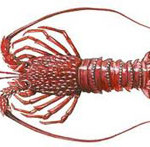
of the families Blennidae & Clinidae
The family of combtooth blennies, Blenniidae is primarily marine, although they are occasionally found in brackish and freshwater. Blennies are diurnal, shallow-water species, and are for the most part found in the tropical and subtropical seas, distributed worldwide, being found in the Pacific, Atlantic, and Indian Oceans, in the Red and Mediterranean Seas, and in the Caribbean. This preference for warmer waters means that of well over 300 species worldwide, only a few will be found in the cooler waters of the Benguela Current.
Blenniids are small, naked-bodied (scaleless) fishes, usually with blunt heads. The pelvic fins are before the pectoral fins and have one short embedded spine and between two and four soft rays. In most species the adults have a benthic (bottom-dwelling) existence, and lack swimbladders, the sac that fish have within their abdomen which is gas filled and is used to control buoyancy. (A natural BCD!)
The Japanese Snake Blenny (Xiphasia matsubarai) is a rare species that inhabits relatively deep waters but rises to the surface at night. It lives in a tube in fine sand or mud and rises to the surface at night where it falls prey to pelagic fishes. Its common name well describes its 30cm long snake-like body.
The Hairtail Blenny (Xiphasia setifer) is easily distinguished from other blennies by an extremely elongate body. Found in tube-like burrows in sand or mud, it feeds at night on a mixed diet of algae and benthic invertebrates. Some of the species that you may encounter in this eco-region are listed below, with their maximum adult length also shown:
- Hairtail Blenny Xiphasia setifer 53cm
- Horned Blenny Parablennius cornutus 15c
- Japanese Snake Blenny Xiphasia matsubarai 30cm
- Looseskin Blenny Chalaroderma capito 20cm
- Molly Miller Scartella cristata 12cm
- Maned blenny Scartella emarginata 10cm
- Ringneck Blenny Parablennius pilicornis 12cm
- Two-eyed Blenny Chalaroderma ocellata 7cm








Social Profiles